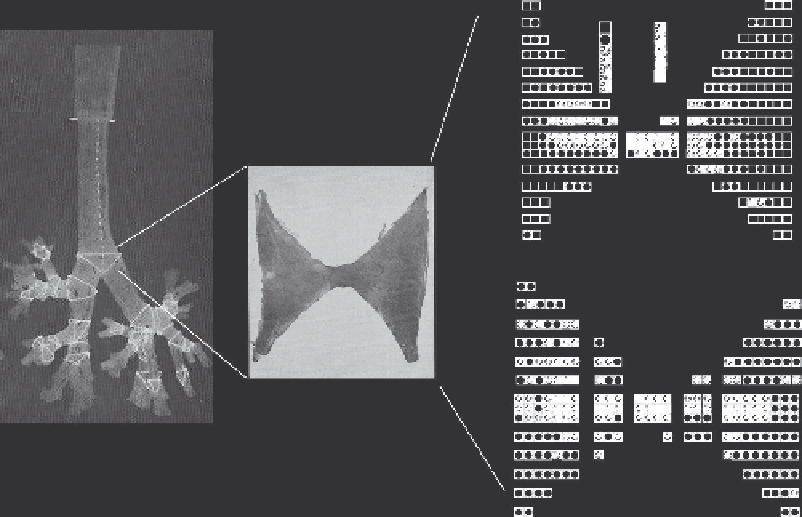Environmental Engineering Reference
In-Depth Information
Constant flow
~15 L/min
(A)
Legend
% of maximum counts/mm
< 1%
1%-10%
11%-20%
21%-30%
31%-40%
41%-50%
51%-60%
61%-70%
71%-80%
81%-90%
91%-100%
Rear
Front
Constant flow
~30 L/min
(B)
Front
Rear
FIGURE 5.12
Determination of localized deposition by Schlesinger et al.
256
for lows of 15 (A) and 30 (B)
L/min. The replica cast, the expanded bifurcation zones, and the resulting measured local deposition are shown.
(Adapted from Schlesinger, R.B. et al.,
Ann. Occup. Hyg
., 26, 47, 1982. With permission from Pergamon Press.)
of the bifurcation surface. Panels A and B of Figure 5.12 show their results for constant low rates
of 15 and 60 L/min, respectively. There is a deinite “hot spot” of deposition at the carinal ridge at
15 L/min, and this area becomes wider with increasing low rate. In addition, Martonen
281
presented
a qualitative description of the local concentrations of 6.7 μm ammonium luorescein particles in
several generations of a bifurcating cast at a constant low rate. Following the deposition of the
particles, the cast was cut open and the distribution of the particles was imaged (Figure 5.13). Note the
“hot spots” of particles at the carinal ridges. Additional studies of the dosimetry or microdosimetry
of inhaled particles would be of great use in the validation of CFPD studies.
5.5.3 c
oMParison
oF
M
odeling
and
d
ata
Validation of deposition modeling results with experimental data is a crucial step in the model-
ing process. Studies comparing simulated particle deposition predictions with experimental results
exist for a wide variety of models. In these studies, simulations of total and compartmental particle
deposition have been examined, with many particle sizes being considered. Stahlhofen et al.
19
pre-
sented a comprehensive overview and summary of large amount of experimentally obtained particle
deposition data, providing a resource for many subsequent modeling investigations.
In the study of the fate of inhaled particles, one must be aware that inherent uncertainties exist
in both experimental data and in model simulations. For example, uncertainty and error may be
imparted into experimental data by uncertainties in the measurement of low rates, particle size
distributions, or experimental deposition measurements, or by intersubject variability in these mea-
surements.
19
Uncertainty in model simulations may depend on one or more of the following: (1)
observational errors in any model input parameters, (2) natural (i.e., intersubject of intrasubject)
variation of model input parameters, (3) the validity of the underlying theory of the model or any
simplifying assumptions, (4) any approximation errors imparted by the computational numerical

Search WWH ::

Custom Search